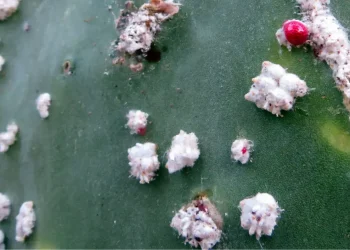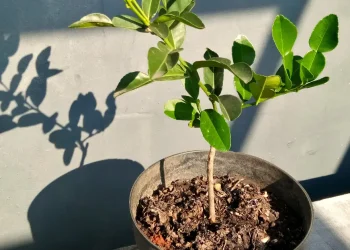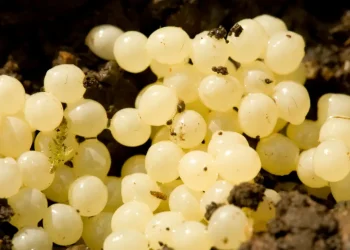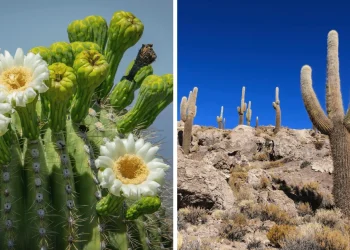Dracaena is a popular houseplant originating from the tropics in parts of Africa, southern Asia, and northern Australia. They are generally quite easy to grow, and giving them enough water and plenty of indirect light is enough to keep them healthy.
But even if your care is spot on, your Dracaena can sometimes show signs of distress in the form of holes in the leaves. And you, as the responsible owner, want to come to the bottom of it.
The number one reason for seeing holes in Dracaena leaves is pests. These are usually only active during the night, so you may have a hard time trying to spot the culprit, but they are definitely there.
In this article, I will highlight other signs that are usually present alongside holes in the leaves, and we’ll, of course, take a look at how to prevent and treat holes in Dracaena leaves. Take on your favorite gardening gloves (you’ll be applying insecticide, which you shouldn’t do without them), and let’s dive in!
Why are there Holes in Dracaena Leaves?
The appearance of holes in Dracaena leaves can be attributed to a range of factors that may challenge the health and vitality of your cherished houseplant. One common culprit is pest activity. Tiny invaders like spider mites, aphids, or caterpillars may take up residence on your Dracaena, nibbling away at its leaves and leaving behind nothing but holes.
The most common pest seen on Dracanea is called Liriyomyza Melanogaster. This tiny fly belongs to the family of leaf-mining flies, but the real culprits here are their larvae. They tunnel through the leaves, fueling their growth. Once the larvae complete the transformation and emerge as adult flies, they will often fly away from the original host plant in search of a new one. The full cycle takes only about 2 to 4 weeks, so before you know it, you can start seeing holes in the leaves of other plants too.
But other pests can cause this type of damage too. It is rather difficult to identify the exact bug that is nibbling on your leaves. One way to do that is by analyzing the hole sizes and shapes and their position. This table should give you a basic guideline.
Is Leaf Spot a Sign of Upcoming Holes in Dracaena Leaves?
While leaf spots and holes may appear to be distant, their presence on your Dracaena leaves can be linked.
Leaf spots, often small, brown discolored areas on the foliage, can signal stealthy activities of sap-sucking pests. They draw nutrients from the leaf, leading to the formation of those spots.
Over time, as the pests persist in their feasting, the affected areas can weaken, leaving the leaf more vulnerable to stressors. This weakening, in turn, creates a favorable environment for opportunistic pests like Liriomyza melanogaster, whose larvae may eventually tunnel through the already compromised leaf, resulting in the distinctive holes that mark their presence.
Or, those sap-sucking pests can, over time, start nibbling your leaves too. In both cases, leaf spots can be a sign of pest infestation in the intermediate stage. This can lead to holes in the leaves if no action is taken.
How to Treat Holes in Dracaena Leaves
Treating Dracaena leaves with holes in it starts by identifying the real cause. The no.1 cause is pests. It’s better if you were able to identify the exact culprit for a more targeted approach. But you can get many different universal insecticides on the market that can still provide an effective way to deal with this issue.
Before you start with targeted treatment, it’s important to quarantine the plant. Pests can infect your whole home garden very quickly – for instance, the whole life cycle of Liriyomyza Melanogaster only takes 2 to 4 weeks, and in that time, it will lay eggs on your other plants, larvae will start nibbling it away, and in the end, there’s another batch of flies laying eggs on your other plants.
Next, you can select and start a treatment. I usually much rather first apply insecticide and then prune the plant. Applying insecticide before pruning can target and eliminate pests, preventing their further multiplication. But the choice between these two approaches depends on your preferences.
And finally, prune affected leaves. Damage done to the leaves is irreversible. By pruning them, you are preventing diseases and helping the plant to focus energy on recovery.
To further support recovery, it’s important to ensure your plant receives proper watering and enough nutrients and sunlight.
How to Prevent Holes in Dracaena Leaves
Pests or diseases can stick to your plant even though you give your plant the perfect care. So it’s not always easy to prevent holes in Dracaena leaves.
The foundation of all efforts is proper watering. Sun damage can burn the leaves, but overwatering can straight up lead to root rot, which can lure pests.
One thing that I found working really well is using neem oil. Neem oil isn’t a strong repellent, but it disturbs many processes in pests, essentially making them unable to feed on your plants. 1 tablespoon of neem oil to about 3 quarts (2.8 liters) of water works great. Mix the solution well and transfer it to a spray bottle for easy application and spray directly on your dracaenas and other plants at your home. Don’t forget to reapply every week.
Conclusion
The holes you can see on your Dracaena leaves are likely from pests.
These little bugs have a very fast reproduction cycle, so it’s important to act fast. First, try to identify the exact cause. If you are unsure, you can reach for a universal insecticide that targets a broader range of houseplant insects. Also, make sure to prune affected leaves to prevent further spreading.
To prevent pests from attacking your plant ever again, you can try a Neem oil solution, which neutralizes many processes in pests.












